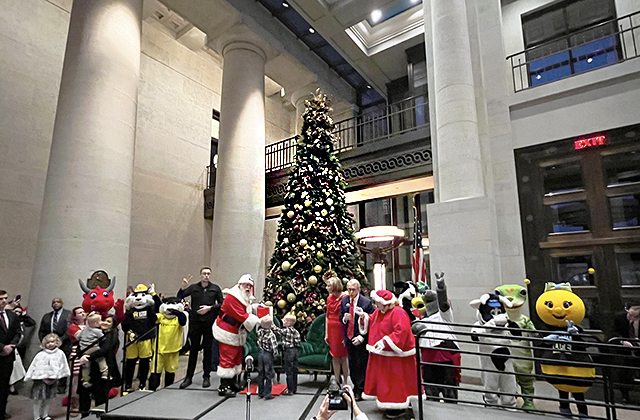About
Visit
Museum
Photos
Video
News
Events



STATEHOUSE NEWS

The Capitol Square Review and Advisory Board (CSRAB) will celebrate Earth Day Wednesday, April 22, 2015 with the dedication of a beehive and planting of a sourwood tree on Capitol Square. Students from Annehurst Elementary, Westerville City Schools, will participate in the Earth Day event that will begin at 10:30 a.m. on the North Plaza of the Statehouse grounds. Also participating will be the Ohio State Beekeepers Association, Central Ohio Beekeepers Association, Nina’s Village Apiary and Davey Tree Expert Co. A book reading will kick off the event followed by remarks from representatives of the participating organizations.
Situated on 10 acres in the heart of downtown Columbus, the Ohio Statehouse grounds serve as an unmistakable green oasis in the heart of the capital city. More than 100 plant species are maintained on the grounds; including a variety of trees, shrubs, perennials and annuals. The grounds continue to serve as a gathering place for the people of Ohio.
“Pollinators make the Statehouse grounds blossom and contribute to a balanced ecosystem. We continue to cultivate a wide variety of beautiful plants here on Capitol Square for all Ohioans to enjoy,” said William Carleton, executive director of the Capitol Square Review and Board.
About honeybees:
- Honeybees are not aggressive by nature, and will not sting unless provoked.
- Honeybees represent a highly organized society, with various bees having very specific roles during their lifetime: e.g., nurses, guards, grocers, housekeepers, construction workers, royal attendants, undertakers, foragers, etc.
- The queen bee can live for several years. Worker bees live for 6 weeks during the busy summer, and for 4-9 months during the winter months.
- The practice of honey collection and beekeeping dates back to the stone-age, as evidenced by cave paintings.
- The honeybee hive is perennial. Although quite inactive during the winter, the honeybee survives the winter months by clustering for warmth; by self-regulating the internal temperature of the cluster, the bees maintain 93 degrees Fahrenheit in the center of the winter cluster (regardless of the outside temperature).
To view this press release and others, visit www.ohiostatehouse.org.
# # #
 Holiday Festival and Tree Lighting 2024
Holiday Festival and Tree Lighting 2024 Holiday Santa Photos 2024
Holiday Santa Photos 2024 2024-11-03 Olympic and Paralympic Celebration
2024-11-03 Olympic and Paralympic Celebration Flags for 9-11 in 2024
Flags for 9-11 in 2024 2024 Volunteer Appreciation Dinner
2024 Volunteer Appreciation Dinner Vintage Base Ball 2024
Vintage Base Ball 2024 Ohio Constitution Videos
Ohio Constitution Videos Ohio Statehouse Videos
Ohio Statehouse Videos






